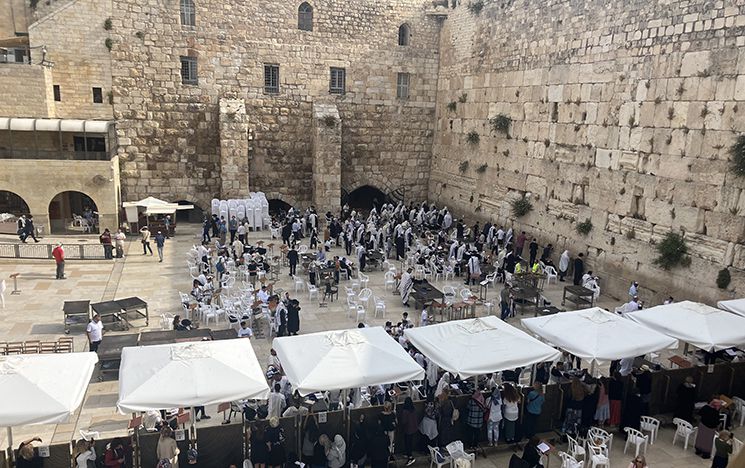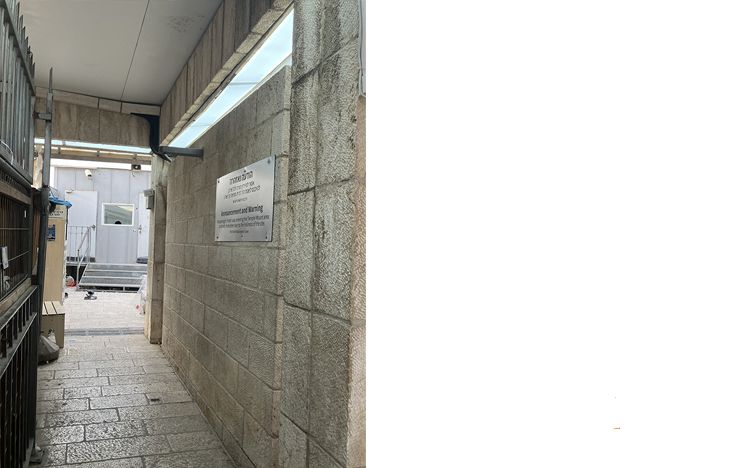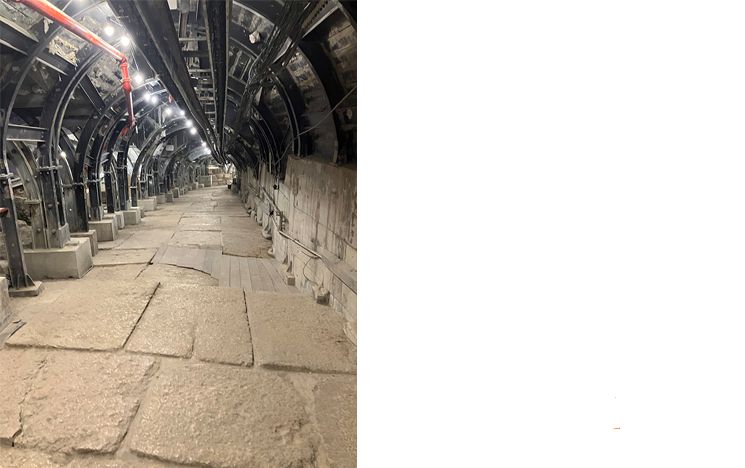What’s in a Name? Pondering Pilgrimage
Shalosh Regalim, Aliyah La’Regel, Tzalyanut and ‘foot’ as a time unit
Gabriele Shenar
One of the recurrent themes in research on contemporary Jewish pilgrimage to Jerusalem, and Israel, points to the very terminological and conceptual realm of pilgrimage. Evidently, the concept of pilgrimage can be used effectively for destination marketing strategies in the tourism industry. The term pilgrimage may also have a wider application both within and outside academic research. Yet, the puzzled looks I frequently encounter in Birmingham when telling people that my ethnographic research focuses on Jewish pilgrimage to Jerusalem suggest that there is a need for further conceptual clarity of what Jewish pilgrimage entails in contemporary society. Significantly, Israeli society embraces a flourishing market of Jewish pilgrimage destinations that go beyond the three pilgrimage festivals to Jerusalem prescribed in the Tanach (Hebrew bible). Alongside the many pilgrimage destinations Jews visit throughout the year, there are also an increasing number of Jewish pilgrimage sites outside Israel, including the Tomb of Rabbi Nachman of Breslov in Uman (Ukraine), Ohel (Chabad-Lubavitch) in New York or the Tomb of Rabbi Elimelech of Lizensk (Poland).
From previous research on Indian Jewish Shrine Hopping in Israel I am attuned to the conceptual ambiguity surrounding modern Jewish pilgrimage practice. ‘Pilgrimage’ is usually translated into Hebrew as aliyah la’regel (Hebrew: עלייה לרגל) which means to ascend or to go up on foot. Interestingly, the use of רגל (regel, English: foot) sometimes causes misunderstanding among Hebrew speakers since in biblical Hebrew רגל may also refer to a time unit. Hence, aliya la’regel appears to be not so much pointing to a journey on foot but rather emphasises the recurrence of the act of ascending to Jerusalem. In other words, while the word ‘foot’ is used in English as a distance or height unit in biblical Hebrew it also refers to a time unit.

Figure 1: Western Wall prayer area Jerusalem, 2023
Aliyah La’Regel and Tzalyanut
Modern Hebrew-speaking Jews in Israel distinguish also between tzalyanut (Hebrew: צַלְיָנוּת ) as a generic term for pilgrimage and aliyah la’regel as a term denoting the visit to an important sacred Jewish site. Moreover, recent interviews with Israeli Jews who have walked the Camino de Santiago, Spain, indicate that Hebrew speakers may use both terms interchangeably. Yet others insist that the term tzaliyanut refers predominantly to Christian pilgrimage and should not be employed to refer to Jewish pilgrimage. The interviews were conducted for a joint research project with Tamar Ben Shlomo, a postgraduate student at the Hebrew University, Jerusalem. The project explores the experiential dimension of Israeli-Jewish journeys on the Camino de Santiago.
Shalosh Regalim - Three Jewish Pilgrimage Festivals
In synagogues around the world, Jews are reminded every year that Judaism’s three Pilgrimage Festivals are referred to in Hebrew as shalosh regalim (Hebrew: שלוש רגלים) and that they relate to the time-bound positive commandment (Hebrew: מִצְוָה) of three annual ascents (Hebrew: עֲלִיָּה) to the Temple (Hebrew: בית המקדש). The Tanach (the Hebrew bible) instructs all able Israelite males to make a pilgrimage to Jerusalem three times a year: for Pesach (Passover), for Shavuot, and for Sukkot. Since the three festivals coincide with important harvest times in Israel they have taken on additional and related meanings. Pesach celebrates the Exodus of the Israelites from Egypt as well as the beginning of the new planting season. Shavuot is celebrated as an agricultural festival and the giving of the Torah at Mount Sinai. Sukkot marks the last harvest festival before the onset of the winter rains. The festival commemorates also the wandering of the Israelites in the desert for 40 years.
____________________________________________
דברים ט״ז:ט״ז
שָׁל֣וֹשׁ פְּעָמִ֣ים ׀ בַּשָּׁנָ֡ה יֵרָאֶ֨ה כׇל־זְכוּרְךָ֜ אֶת־פְּנֵ֣י ׀ יְהֹוָ֣ה אֱלֹהֶ֗יךָ בַּמָּקוֹם֙ אֲשֶׁ֣ר יִבְחָ֔ר בְּחַ֧ג הַמַּצּ֛וֹת וּבְחַ֥ג הַשָּׁבֻע֖וֹת וּבְחַ֣ג
הַסֻּכּ֑וֹת וְלֹ֧א יֵרָאֶ֛ה אֶת־פְּנֵ֥י יְהֹוָ֖ה רֵיקָֽם
Deuteronomy 16:16
Three times a year—on the Feast of Unleavened Bread, on the Feast of Weeks, and on the Feast of Booths—all your males shall appear before your God יהוה in the place that [God] will choose. They shall not appear before יהוה empty-handed,
שמות כ״ג:י״ז
שָׁלֹ֥שׁ פְּעָמִ֖ים בַּשָּׁנָ֑ה יֵרָאֶה֙ כׇּל־זְכ֣וּרְךָ֔ אֶל־פְּנֵ֖י הָאָדֹ֥ן
יְהוָֽה
Exodus 23:17
Three times a year all your males shall appear before the Sovereign, יהוה.
____________________________________________

Figure 2: Warning sign and lockers at entrance to Mughrabi Gate, Jerusalem, 2023
All-night Bus Services for Pilgrimage to the Western Wall on Tisha B’Av
There seems to be no agreement as to whether aliyah la’regel is still obligatory today, though it is widely assumed that the commandment was annulled with the destruction of the Second Temple by the Romans in 70 C.E. On Tisha B’Av (the ninth of the Hebrew month) Jews around the world mourn the destruction of the two Temples as well as other major afflictions which have befallen the Jewish people throughout history. Religiously observant Jews fast, sit on low chairs and follow various other rules and customs that have come into being to embody and perform the act of mourning. In synagogues around the world, the Book of Eicha (Book of Lamentations) is read, which mourns the destruction of Jerusalem. This liturgical reading is followed by the recitation of kinnot, Hebrew dirges (sad poems) or elegies. During my research I observed large crowds gathered at the Western Wall prayer area and the adjacent Western Wall Plaza to collectively enact the aesthetics of a day of national mourning at the very site where Judaism’s two Temples once stood and were destroyed. Israel’s Transportation Ministry, led by the current Deputy Minister for Haredi Development, Uri Maklev (United Torah Judaism), decided to increase public transportation to the Western Wall for the duration of Tisha B’Av. In other words, religious and political authorities linked up with business strategies and logistics planning to facilitate access to the Western Wall. Hence, buses were running throughout the night which enabled Jewish pilgrims’ travel to and from the Western Wall.
Mourning Ambience and Circle Dances
After the public reading of the Book of Lamentations at the Western Wall groups of people and families strolled through the Jewish Quarter where young Haredi men assembled to sing mournful songs until late at night. They attracted a sizable audience some of whom spontaneously joined the singing. At times the mourning ambience that filled the Western Wall Plaza area and the adjacent Jewish Quarter spilt over into emotional displays of unity and continuation. Groups of young people spontaneously joined circle dances and the singing of patriotic songs. Some Jewish pilgrims looked bewildered upon the singing and dancing unfolding in front of their eyes. One woman, repeatedly shaking her head, thought out aloud what others around her seemed to be thinking: ‘Don’t these young people understand what Tisha B’Av is all about? This is supposed to be a day of mourning. Why are they dancing?’ While Judaism’s three Pilgrimage festivals are now mainly synagogue centred religious festivals with agricultural and biblical connotations, the practice of ascending to Jerusalem arguably has not lost its emotional, aesthetic, cultural, and political appeal.
Har ha-Bayit, Temple Mount and Haram al-Sharif
Significantly, ascension to the Temple Mount, rendered in Hebrew har ha-bayit (Muslims refer to the site as haram al-sharif (Noble Sanctuary) or Al-Aqsa Mosque compound, or simply Al-Aqsa) continues to be a highly contested terrain for Jews due to its halachic (halacha: Jewish Religious Law), theological and political implications and the various discursive narrative strategies that have formed around it. Since 1967, when Israel re-captured the Old City from Jordan, Israel’s Chief Rabbinate ruled several times that ascent to the Temple Mount was prohibited according to Torah Law. A sign at the entrance to the Mughrabi Gate, the only gate through which tourists and Israelis can currently access the Temple Mount, reminds visitors of this ruling.
Yet, the debate continues, especially within Israel’s Religious Zionist camp which itself is divided along ideological, theological, halachic, and political lines. Furthermore, since 1967 the status quo has been in place according to which Christians and Jews may only visit the Temple Mount as tourists and prayers are not permitted. Israeli security guards at the checkpoint search all visitors and anyone who carries a prayer book will be asked to leave it in one of the lockers at the entrance. During my fieldwork in 2023, tourists and Israelis gained access to the Temple Mount only via the Mughrabi Bridge, and only on specified days and times during the week. Any attempt to enter the Temple Mount via one of the other gates was thwarted by Israeli security forces present in the Old City. At the same times, Muslim tourists were turned away from the Mughrabi Bridge entrance.

Figure 3: Excavated Pilgrimage Road from Shiloach Pool to Temple Mount, Jerusalem, 2023
Some members of the Jewish community in Birmingham remember that in the early 1980s they ascended to the Temple Mount through one of the many entrance gates located in the Muslim Quarter of the Old City. They also remember that it seemed possible to enter the Al-Aqsa Mosque and the Dome of the Rock though reportedly only against a fee. One of my interlocutors considered the fee that was asked of her as too high and hence decided not to go ahead with visiting the site. During one visit to the Temple Mount in 2023, a Swiss tourist was approached by young Palestinian man who was hanging out near the Dome of the Rock. He was asked if he would like to have a picture taken of the interior of the Dome of the Rock as access to the interior of the building was allowed only to Muslims. Since this was to entail handing over his smart phone and the payment of a fee, the tourist politely declined in English and walked off. Residents of the Jewish Quarter in the Old City, too, reminisce that during the late 1960s and 1970s they used to walk across the Temple Mount’s vast plateau on an almost daily basis.
While access to the Temple Mount remains debated, prohibited, contested and restricted, recent archaeological endeavours have uncovered Jerusalem's 2,000-year-old Pilgrimage Road that used to lead up to the Temple. Moreover, the Western Wall Heritage Foundation launched an innovative augmented reality (AR) application in 2023, named “Kotel AR” . The app allows visitors to the Western Wall to see an overlay of virtual reality from the Second Temple era. Indeed, the increasing use of digital technologies impacts the religious and spiritual landscape of Jerusalem’s various holy sites. Importantly, it impacts the ways in which these sites are accessed, experienced and documented. On the other hand, local entrepreneurs may utilise the symbolic cultural capital of aliyah la’regel for their business ventures. A good example here is a small takeaway coffee place at the Dung Gate, one of the entrances to the Western Wall Plaza. The coffee shop is named ‘Café Olei Ha’regel’ (Hebrew: קפה עולי הרגל), Pilgrims’ Café.

Figure 4: Pilgrims’ Café, near Dung Gate, Jerusalem, 2023